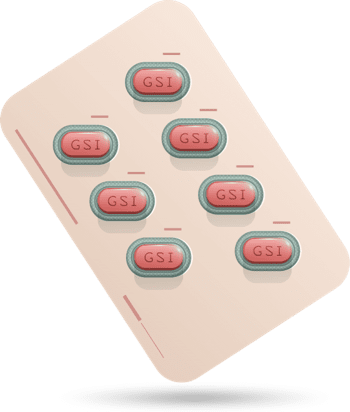Dosing & Administration

Once-daily STR
Taken any time of day
No food requirement
No booster
- BIKTARVY is not recommended in patients with severe hepatic impairment (Child-Pugh Class C). For patients weighing ≥25 kg, BIKTARVY is not recommended in patients with severe renal impairment (estimated CrCl <30 mL/min) except in virologically suppressed patients with CrCl <15 mL/min on chronic hemodialysis. BIKTARVY is not recommended for patients weighing ≥14 kg to <25 kg with CrCl <30 mL/min.1
A Way to Help Your Patients Keep Track of Treatment

Image for illustrative purposes only.
Actual packaging may differ.

Daily Dosing Markers
One week of pills on each card,* so your patients can visually track their daily dose

Portable Design
Only slightly larger than a credit card, it may fit in a jacket pocket or small bag to help keep treatment close*

Refill Reminders
30-day reminders that may prompt your patients to refill prescriptions
*Each card in a pack is 106 mm x 71 mm x 8.5 mm. Four cards hold 7 pills, and one card holds 2 pills, for 30 pills total per pack. Store at room temperature between 68˚ F and 77˚ F. Keep each pill in original blister pack until use.
Common questions
How many pills come in a pack?
Each pack contains 30 pills total: 4 cards carrying 7 pills each, and 1 card that holds 2 pills.
Does the BIKTARVY ANYWHERE™ blister pack cost more?
There is no added cost compared to BIKTARVY dispensed in a bottle.
Please use NDC: 61958-2501-3 for this packaging option
NOTE: The name "Anywhere" will not appear in the EHR system.
Simple Dosing in a Small STR

BIKTARVY combines the DESCOVY® (FTC/TAF)† backbone with bictegravir, in a small and powerful unboosted STR.
Not actual size. Actual size is 15 mm x 8 mm.3
STR Size ComparisonCompare BIKTARVY tablet size to that of other single‐tablet regimen options.
Compare BIKTARVY tablet size to that of other STR options*
This chart is not inclusive of all HIV STR options or formulations†

15 mm x 8 mm
BIKTARVY®
(bictegravir/

22 mm x 11 mm
TRIUMEQ®
(dolutegravir/

18.5 mm x 9.5 mm
DOVATO®
(dolutegravir/

22 mm x 11 mm
SYMTUZA®
(darunavir/
*Pills are not actual size. Pill sizes are shown according to a set scale.
†This chart does not include the complete prescribing and dosing considerations, use in specific populations, or laboratory monitoring
requirements for using these medications. Please refer to the full Prescribing Information for each medication. Comparison of agents does not
imply comparable indications, appropriate patient populations, clinical effectiveness, safety, or tolerability.
STR, single-tablet regimen.
References: 1. Electronic medicines compendium. Biktarvy 50 mg/200 mg/25 mg film-coated tablets—summary of product characteristics (SmPC). Accessed June 27, 2024. https://www.medicines.org.uk/emc/product/9313 2. Electronic medicines compendium. Triumeq 50 mg/600 mg/300 mg film-coated tablets—summary of product characteristics (SmPC). Accessed June 27, 2024. https://www.medicines.org.uk/emc/product/3318 3. Electronic medicines compendium. Dovato 50 mg/300 mg film-coated tablets—summary of product characteristics (SmPC). Accessed June 27, 2024. https://www.medicines.org.uk/emc/product/10446/smpc 4. Electronic medicines compendium. Symtuza 800 mg/150 mg/200 mg/10 mg film-coated tablets—summary of product characteristics (SmPC). Accessed June 27, 2024. https://www.medicines.org.uk/emc/product/8430
BIKTARVY tablets (30 count) are dispensed in a sealed Gilead-branded bottle or blister pack. Authentic BIKTARVY tablets are purplish brown and capsule-shaped, imprinted with "9883" on one side and "GSI" on the other.
†emtricitabine 200 mg/tenofovir alafenamide 25 mg.
A small STR with simple dosing may offer your patients the flexibility to take their daily treatment as their schedule allows

BIKTARVY Patient Brochure
The brochure provides information about BIKTARVY and how it can help your patients, whether they are new to treatment or switching from another regimen, reach important HIV health goals like staying undetectable.
Download BIKTARVY Patient Brochure (English) Download BIKTARVY Patient Brochure (Español)CrCl, creatinine clearance; EHR, electronic health record; FTC, emtricitabine; STR single-tablet regimen; TAF, tenofovir alafenamide.
References: 1. BIKTARVY. Prescribing information. Gilead Sciences, Inc.; 2024. 2. Data on file. Gilead Sciences, Inc. 3. Electronic medicines compendium. Biktarvy 50 mg/200 mg/25 mg film-coated tablets—summary of product characteristics (SmPC). Accessed June 27, 2024. https://www.medicines.org.uk/emc/product/9313


